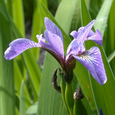| At the Church Street entrance to River Walk, we have created a “rain garden” in the W.E.B. Du Bois River Park to demonstrate how natural systems like wetlands can help to cleanse stormwater runoff and also be beautiful.
This is one of the most important things you can do to protect an urban river.
Prior to creating this garden, drainage from the nearby roads and parking lots collected in the catch basin and piped directly into the Housatonic River. Contaminated stormwater containing road salt, oil and sediments substantially degrades the Housatonic in developed areas. The garden is intended to divert some of this runoff into the shallow man-made wetland depression in front of you.
Sediments and other contaminants settle out, along with some heavy metals like lead. Native wetland plants like Joe-Pye Weed, Cardinal Flower, Cattail and Swamp Milkweed help to remove some of the contaminants and nutrients from the stormwater. These include nitrogen and phosphorus, which can cause eutrophication (excessive growth of aquatic vegetation) if they get into streams and rivers. Some of the water can soak into the subsoil to recharge groundwater.
During heavy storms, excess runoff is stored before overflowing into the catch basin. The cleansed runoff water then discharges to the river.
Native non-invasive plant communities may vary seasonally and according to the precipitation in any given year. During the summer, a drain in the bottom of the catch basin is opened to minimize stagnant water and mosquito breeding.
We hope you enjoy this example of nature at work. |



